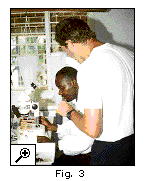|
|
 |
|
| |
With more than 1,500 species of plants and animals, and half of them unique to the Tanganyika ecosystem, the biodiversity of Lake Tanganyika is extremely rich and complex. In order for the BIOSS teams to conduct surveys and censuses to monitor biodiversity, it was necessary to train team members in taxonomy.
Using specialists from both European and African museums and universities, LTBP conducted three taxonomic training sessions for BIOSS team members (Fig. 3). In September 1997 and July 1998, the Anglophone and Francophone teams, respectively, participated in introductory taxonomic training sessions. This was followed by an intensive session for all team members in Kigoma in March 1999.
One of the mandates of the BIOSS programme is to understand the biodiversity of the aquatic areas bordering national parks. The idea is that since the terrestrial catchment region of the park is already protected from human impacts, the adjacent waters are similarly protected.
There are four national parks bordering Lake Tanganyika. As a joint initial research effort, all the BIOSS team members surveyed Gombe Stream National park (Tanzania) after their dive training. The Burundian team conducted both terrestrial and aquatic surveys of Rusizi National Park (Burundi). The four national teams reunited in Tanzania last March for a joint survey of the more than 60 kilometres of Mahale Mountains National Park (Tanzania) (Fig. 4). The Zambian team then surveyed Nsumbu National Park in July 1999.
|
|